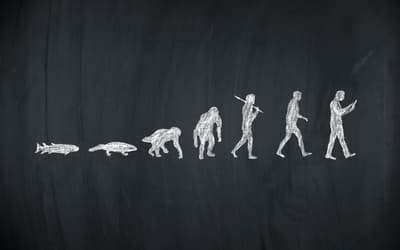Research conducted by Answers in Genesis staff scientists or sponsored by Answers in Genesis is funded solely by supporters’ donations.
Abstract
I review scientific and biblical problems with the teachings of Hugh Ross, based upon his most recently published book. As I showed in a previous study of his earlier works, Ross poorly handles both scientific facts and biblical texts. While many Christians support Ross’ broad conclusions, few would agree with the details of Ross’ argument.
Keywords: Hugh Ross, local flood, day-age theory
Introduction
This most recent book by Hugh Ross appears to be his tenth book as a single author. I say appears, because after reading this book, I realized that it really is a revision of an earlier book, The Genesis Question, (Ross 1998) that has already been through a second edition. However, there is nothing in this new book that clearly suggests that it is a new edition of The Genesis Question, and this book even carries a different title. Many of the chapter titles, as well as the text, are the same in these two books, though there has been some editing and some rearrangement of the material in the latter book, which is consistent with a new edition rather than a new book.
I previously offered an evaluation of Ross’ apologetics (Faulkner 1999). Though that article included material from The Genesis Question, I have endeavored not to repeat that discussion here. Rather, I focus here on issues that I did not previously raise. As I demonstrated earlier, Ross badly handles both biblical texts and current scientific thinking. In Navigating Genesis, Ross gives more specific information about his model of a local flood. My analysis of that model is more in-depth than the other topics that I treat here, so I have published my critique of Ross’ local flood model separately (Faulkner 2015a).
A Supernova as the Cause of Reduction of Human Lifetimes as Recorded in Genesis
There are some differences between the earlier and later books. For instance, on pp. 117–121 of The Genesis Question, Ross concluded that a supernova explosion thousands of years ago produced cosmic rays that played a significant role in diminishing human lifetimes after the Flood. He even concluded that the supernova that created the Vela pulsar was “the only supernova eruption that could possibly be implicated in the shortening of human life spans . . . .” On pp. 125–128 of Navigating Genesis, Ross repeated this discussion, except this time he discounted the Vela supernova and claimed that the culprit actually was the supernova that created the pulsar PSR B0656+14. So Ross’ earlier absolute statement that the supernova that created the Vela pulsar was “. . . the only supernova eruption that could possibly be implicated in the shortening of human life spans . . .” is not true. The case for either supernova was based upon the supposed distance, age, and other characteristics of the respective supernova events. One must question whether in the future Ross will distance himself from yet another supernova event.
Early Planetary Atmospheres
As in The Genesis Question, in Navigating Genesis Ross discussed the supposed early evolution of planetary atmospheres. As before, Ross claimed that early in its history Earth had an opaque atmosphere. This is in concordance with his manner in interpreting the sun, moon, and stars appearing on Day Four of the Creation Week. In Ross’ view, rather than God making astronomical bodies on Day Four, God made astronomical bodies earlier and they became visible on Earth’s surface Day Four as the earth’s atmosphere cleared. However, this is an old idea, as planetary scientists abandoned that theory decades ago in favor of a terrestrial atmosphere that was transparent very early (Kasting and Catling 2013). Therefore, Ross’ theory about Earth’s early atmosphere is far out of date from what most planetary scientists think, though most readers probably would not know this. In his new book, Hugh Ross wrote (2014, p. 34):
They’ve learned that Planets as massive as Earth and as distant from their host star (their “sun”) typically start with a thick, opaque (light-blocking) atmosphere. The smallest of the extrasolar (outside our solar system) planets for which astronomers have a measurement of the planets’ atmospheric mass is 6.5 times more massive than Earth and has an atmosphere at least 4,000 times “heavier” than Earth’s atmosphere today.
There are at least two things wrong with this statement. First, the reference that Ross gave for this (Miller-Ricci and Fortney 2010) did not measure the atmosphere of the planet in question (GJ 1214b). Rather, they offered a range of possible model atmospheres for this planet based upon the planet’s observed mass and radius. Both the mass and radius of the planet have uncertainties, so the actual structure of its atmosphere is unknown. Second, Ross used this reference in evidence of his claim that planets of this type “typically start with a thick, opaque . . . atmosphere.” However, not many astronomers would suggest that GJ 1214b is a young planet. The inferred metallicity of the host star GJ 1214 is similar to the sun’s metallicity (Rojas-Ayala et al. 2012), suggesting a comparable age. Current models of planet formation (which Ross endorses) suggest that planets have ages similar to their host stars. Thus, the extrasolar planet GJ 1214b is conventionally dated as being several billion years old, and so cannot be used to support Ross’ contention that planets begin with thick, opaque atmospheres. Also, it is not clear where Ross got his figure of an atmosphere that is “at least 4,000 times ‘heavier’ than Earth’s atmosphere today.”
Ross continued his discussion of early planetary atmospheres and stated that (2014, p. 34):
Thus, astronomers estimate that the Earth’s primordial atmosphere was a least 200 times more massive than our current atmosphere.
There is no reference given for this, probably because astronomers do not estimate this. Apparently, this estimate is Ross’, and is based upon his discussion of the atmosphere of Venus. Ross correctly pointed out that Venus’ atmosphere is 91 times greater than Earth’s atmosphere, and then he reasoned that Venus’ weaker gravity and closer proximity to the sun would have caused Venus to lose more of its atmosphere into space. There are several problems with this. Is Ross suggesting that Earth’s atmosphere is more evolved so that Venus’ atmosphere is more primitive? If so, this is a very old idea that was long ago discarded by planetary scientists. For some time, planetary scientists have viewed Venus’ atmosphere as mature, but that the atmospheres of Earth and Venus took decidedly different evolutionary paths. Venus’ atmosphere is dominated by CO2, so the question arises why the Earth does not have a CO2 based atmosphere. The answer is that much of Earth’s CO2 is bound up in carbonate rocks. Planetary scientists have devised a theory, the runaway greenhouse effect, to explain why Venus has much of its CO2 in its atmosphere. Furthermore, Ross’ reasoning here does not make sense. He stated that he would expect that Venus would have dissipated more of its atmosphere into space, but then he argues that the Earth lost far more—a reduction from 200 greater than the current atmosphere to the current atmosphere is a 99.5% reduction.
The Early Earth
On p. 36, Ross stated that:
Earth’s rotation rate has decreased by a factor of three or more over the past four billion years as a result of tidal interactions among Earth, the Sun, and the Moon.
Since the Earth now rotates with a period of about 24 hours, a three-fold decrease in the day’s length would have required the day have been eight hours, or even less when one considers Ross’ claim that the change was “a factor of three or more.” However, this rotation period for the early Earth is far too short. Hansen (2010) ran several models and found a range of 12–18 hours for the Earth’s rotation period 4.5 billion years ago.
On pp. 34–36 Ross described the early Earth as being covered by a deep ocean with no land reaching above the ocean, all allegedly in concordance with the use of “the deep” in Genesis 1:2. The Hebrew word translated “the deep” is better rendered “watery abyss,” but the early Earth being covered by water is best indicated by the context. One infers from the lack of mention of any removal of this water until Genesis 1:9 that this water continually covered the Earth until the dry land appeared on Day Three. In Ross’ view, this fact from Genesis 1 had been proved by modern science, but has it? The question of how deep the water on the Earth’s surface billions of years ago has been debated for some time among evolutionary scientists. For a while, most scientists thought that if the Earth initially had any bodies of water, they were removed and later replaced with water brought to Earth by impacts of asteroids and comets, but recent studies of crystals that must form in water have suggested that liquid water existed very early in Earth’s history. However, the mere presence of liquid water on the Earth’s surface does not imply that the Earth was deeply covered by water. Most scientists today probably would disagree with Ross’ assessment that water deeply covered the early Earth.
A few pages later (pp. 39–41), in discussing the origin of the moon, Ross described the current grazing impact theory of lunar origin. He observed that the impact that formed the moon would have blasted most of Earth’s original opaque atmosphere into space and allowed a translucent replacement atmosphere. Ross dates this event to Day One, when God commanded that there be light and He separated the light and dark. That is, light on the surface of the Earth (the perspective of the creation account) became possible when the atmosphere was sufficiently cleared by the impact that formed the moon. Thus Ross dates Day One very early, close to 4.5 billion years ago. However, the supposed impact that formed the moon probably would have removed the Earth’s ocean as well as most of the atmosphere. Indeed, no one has dated liquid water on the Earth prior to 4.4 billion years ago, 100 million years after the impact. Therefore, there is a problem with Ross’ insistence that water completely covered the Earth prior to Day One.
The Light for the First Three Days
On p. 55, Ross attempted to dismiss the suggestion of many recent creationists that God was the source of light for the first three days, or, more specifically, that the light present was God’s Shekinah glory.1 Ross refers to exegetical problems for this suggestion, though he did not discuss those. Rather, he concentrated on a “wall of scientific implausibility” that this suggestion supposedly runs into. For instance, the first problem that he listed was that the light needed exactly to match the sun’s light in spectral response and effective temperature. This betrays materialist thinking on Ross’ part in that it amounts to a denial of God’s ability to act miraculously to match the sun’s spectrum. It may be more accurate to say that God on Day Four made the sun so that its spectrum matched the original light that He created on Day One. This underscores a serious problem underlying Ross’ creation apologetic—he fails to acknowledge the tremendous role that the miraculous played in the creation. Creation by its very nature is miraculous. One may just as well throw up scientific objections to the miracles of the virgin birth and resurrection. Furthermore, underlying this objection is the assumption of millions of years. Of course plants could not long survive without the light of the sun or something that closely matched the sun’s light, but not if the time involved is at best a day, for plants today easily survive such lapses of sunlight.
Behemoth and Leviathan
On p. 65, Ross stated that dinosaurs probably were created and existed on Day Five. These were the largest land animals that ever lived, yet Ross insists that they weren’t made on the day that God made land animals. Continuing on this page, Ross stated,
Some Christians assert that the Bible does speak of dinosaurs. They claim the “behemoth” and “leviathan” of Job 40 and 41 must be references to Triceratops, Tyrannosaurus rex, or some other dinosaur species.
This is a misrepresentation of the recent creation position, for these are not the creatures that recent creationists generally identify with the behemoth and leviathan. Rather, behemoth is identified as some sort of sauropod and leviathan as possibly a plesiosaur. Ross might claim that his phrase “or some other dinosaur species” would suffice, but this hardly would describe plesiosaurs, since most scientists believe that plesiosaurs were not dinosaurs. There may be some recent creationist who has made the identifications that Ross suggests, though I am not aware of anyone who does. Even if someone did make this identification, it hardly is representative of the recent creation position. On the next page (p. 66), Ross discusses what he thinks that the behemoth and leviathan were. He noted that the singular form of behemoth, behema,2 appears in Genesis 1, where he says that it is “part of the description of certain land mammals created on the sixth creation day.” However, there is no reason why behema must refer only to land mammals (excluding reptiles or other classes that dinosaurs likely belonged to). Rather, behema refers to large land animals. The only reason why Ross insists that behema must refer to land mammals is his belief that God made dinosaurs on Day Five rather than Day Six.
The Sabbath and the Day-Age Theory
On p. 86, Ross linked Sabbath rest of farmland with pest control. However, pest control is best handled with the related practice of crop rotation, not allowing land to be fallow. Probably more important for the Sabbath rest of farmland is the recovery of soil with regards to nutrients and fertilizer.
In arguing for the day-age theory, on p. 88 Ross enlisted Psalm 95:7–11, John 5:16–18, and Hebrews 4:1–11, as well as Revelation 21 in support of his claim that the seventh day of creation is continuing today. However, none of these passages supports this position. Written by David, Psalm 95 warned Israel not to harden their hearts as their forbears had done in the wilderness. That generation spent 40 years in the wilderness (verse 10), and the LORD swore in His wrath that they would not enter His rest (verse 11). The seventh day, the Sabbath, is not mentioned in Psalm 95. Rather, the context is the denial of that generation entering the Promised Land. The Promised Land offered peace, prosperity, and security, amounting to a form of rest when compared to the wilderness wondering. David’s warning implied that the people of Israel, because of their unbelief, still had not yet fully entered that state of rest. Therefore, Psalm 95 is not about the Sabbath, and the claim that it in some way supports the notion that Day Seven of the Creation Week is ongoing is false.
Hebrews 4 quotes liberally from Psalm 95. Verse 1 encourages believers to enter God’s rest, in some sense a rest comparable to that of the rest promised to those who would enter the Promised Land. Hebrews 4:3 assures us that those who believe will enter that rest, and it quotes a portion of Psalm 95:11. Hebrews 4:7 implies a warning to us today not to harden our hearts in its quotation of a portion of Psalm 95:7–8. However, the rest spoken of in Hebrews 4 is a comparison to the rest promised to ancient Israel, not equivalence, as nearly any commentary of Hebrews will concur. For instance, consider the words of Hewitt (1960, pp. 85–86):
The unbelieving Israelites who perished did not nullify the promise that some would enter into God’s rest, nor was the promise fulfilled when their children entered the promised land. The rest that these enjoyed was only a type of God’s rest and, therefore incomplete. The promise of God that some should enter His rest still remains, but in the light of what happened to those who left Egypt an exhortation to fear is given to the readers. This exhortation carries with it a suggestion that each reader should examine himself lest he be still not in the way which leads to that rest.
Hebrews 4 speaks of a rest that is eternal. It draws upon Psalm 95 in order to make a thematic connection. Psalm 95 speaks of rest in the land (of Israel) which is only reflective of the rest in Genesis 2 (and imperfectly so, at that). Hebrews 4 picks up on this intertextual connection and traces out the implications; that is, showing how these verses anticipated a greater future rest. But this is thematic expansion/development, not equivocation that demands that Genesis 2 speaks of ongoing rest. Incidentally, Revelation 21–22 shows the attainment of the anticipated rest. Ross has identified correctly the thematic connection between these texts, but has read into the earlier texts a meaning that is not present in them. Hebrews 4:8 states that if Joshua had given Israel rest upon entering the Promised Land, then David (writing in Psalm 95) would not have spoken of some other day of rest. Hebrews 4:4 compares this rest to the seventh day rest in quoting Genesis 2:2 that God rested from creating on the seventh day. However, this is not to be confused with the Fourth Commandment, which is a mere picture of God’s rest. The only connection to the Fourth Commandment in Hebrews 4 is in verse 9. Up to this point, the writer of Hebrews used the Greek word katapausis for rest, but in verse 9 he used the word sabbatismos, meaning Sabbath rest. This is only time that this word appears in the New Testament, and the writer may have coined the word when he used it. Most commentators believe that this term was used in a spiritual sense. The final encouragement for us to enter that rest in verses 10–11 certainly reinforces that interpretation.
Obviously, the rest, even the Sabbath rest mentioned in Hebrews 4 is a type, and to take from this passage some subtle support for the day-age theory is to miss the entire point of this passage. Perhaps it is the use of the word “today” in Hebrews 4:7 and Psalm 95:7–8 that has confused Ross into thinking that “today” here refers to an ongoing seventh day of the creation. However, the “today” here refers to the moment and to the urgency in making a decision (this is reminiscent of 2 Corinthians 6:2, which in turn is quotation from Isaiah 49:8).
As for John 5:16–18, it is a bit bizarre to suggest this passage teaches the ongoing nature of the seventh day of creation. The context of this passage is that Jesus had healed a man who couldn’t walk. Some of the Jews sought to kill Jesus, because He had done this on the Sabbath. Jesus replied that as His Father worked still, so did He, which caused the Jews to want to kill him even more. It is a complete mystery how this passage supports the belief that the seventh day of the Creation Week has not ended and hence is continuing today.
Ross further stated that (p. 88)
Revelation 21 tells us that the seventh day will eventually end for us, when God’s purposes for this cosmos have been fulfilled and God unveils an entirely new heaven and earth for us, a new creation with new physical laws, appropriate, as always, to the fulfillment of His divine purposes and plans for life beyond cosmic time.
Revelation 21 does describe a new heaven and a new earth, as well as a New Jerusalem. However, there is no hint of the closing of the seventh day here, nor new physical laws. Ross has conjectured these and attempts to use Revelation 21 to support his teachings on this, but the chapter does not teach these things. His claims on this at best grossly misrepresent the text.
Ross went on to make his case for the day-age theory by appealing to differences between English and Hebrew, blaming the supposed misunderstanding of the Creation Week on the part of recent creationists as being seven normal days upon their lack of appreciation of the differences between the two languages. On pp. 88–89 he correctly pointed out that our English word day carries several different meanings, and even gave examples of one meaning, referring to a period of time. He also pointed out that a reader has no problem figuring out which meaning is intended, presumably from context. Furthermore, Ross went on to note that the Hebrew word for day, yom, has at least four distinct possible meanings too, and he listed those.3 Ross must not have compared his lists of meanings for the English word day and the Hebrew word yom, for if he had, he would have realized that the lists are virtually identical. That is, the two words in two very different languages have the same possible meanings. Ross argued that Hebrew has a much more limited vocabulary than English, I suppose based upon a count of Hebrew words in Bible concordances. Hebrew may have fewer words than English, but primarily because English is far too rich in synonyms. This oversimplifies much, because Hebrew has subtleties that don’t exist in English. For instance, Hebrew is exceptionally rich in verbs, and has a well-developed array of nouns related to specific subjects. Although the total vocabulary in the Old Testament does not equate to that exhibited in English dictionaries, the fact remains that the English vocabulary is comprised mostly of dead or unused words. Also, whereas English words are each given independent entries in the dictionary (even if two or more lexemes are closely related), this is not so with Hebrew words. For instance, all verb forms are listed in lexicons by root rather than according to individual lexemes. However, a great number of common Hebrew verbs can occur in as many as seven distinct stems, and in several distinct forms, with each form having a distinctive meaning.
Ross’ appeal to the differences between English and Hebrew and the smaller vocabulary of Hebrew as compared to English is an attempt to hoodwink the reader. Apparently, Ross thinks that it is not possible to discern the intended meaning of the word yom from context in Hebrew as we can in English. As with any language, context is the key in understanding, and there are ample contextual reasons for concluding that the clear meaning of yom in Genesis 1 is a normal day.
Ross further stated on p. 89 that “. . . the Bible contains dozens of lengthy biblical texts on various themes relevant to creation . . .,” and that “an integrative analysis of all these passages leads to the conclusion that yom refers to a long, but finite, time period.” However, Ross has yet to produce this integrative analysis, preferring instead to assert that such an analysis produces this conclusion. This has been a tactic of Ross for some time, for the list of passages that he offers as evidence here (Table 9 on p. 90), as well as similar lists and expanded lists of supposed creation passages, exist elsewhere in his publications. However, close examination of these lists show that these passages do not support his claim that the passages teach the day-age theory. For instance, I recently examined a much longer list that Ross had published and found Ross’ claim baseless (Faulkner 2015b). Indeed, they identified several alleged creation passages on the list that did not pertain to creation at all.
The Early Church on the Age of Creation
To further his case, Ross once again repeated claims that the early church taught that the creation was long ago. On p. 91 he wrote:
Ante-Nicene scholars (those prior to AD 325) devoted some two thousand pages of commentary to the “hexameron,” the portion of Genesis 1 describing the six creation days. No other section of Scripture received more of their attention. Yet in all their pages of commentary, only about two address the meaning of “day” or the time frame for creation. Their comments on the subject remained tentative, with some favoring the day-age (typically a thousand-year period) interpretation—and their studies preceded the influence of science. No one explicitly endorsed the 24-hour-day interpretation.
Ross frequently makes these sorts of statements, and he does so with such conviction, such certainty, and seemingly with much authority. While some of what Ross says here is technically correct, his conclusion is far from correct. Ross offered no examples here, but instead he referenced something that he had previously written (Ross 2004, pp. 41–49). In his earlier work, Ross did discuss a few examples, and he is correct that the early church writers rarely discussed the length of the creation days. Obviously, the lack of discussion of the length of the creation days indicates that, unlike today, in the early Christian era there was not much question about the length of those days. For a good refutation of Ross and others in their claims that the early church fathers believed in the day-age theory, please see the excellent review by Mook (2008). Ross also is correct that some early church writers tentatively put forth the possibility that the days could be thought of in terms of a thousand years. They used Psalm 90 and Peter’s quotation of Psalm 90:4 in 2 Peter 3:8 for their suggestion. However, this often was driven by a belief that there would be 6000 years of history in parallel to the six days of creation, a belief that is still popular today. In the early church era, there also arose the thought that the creation was instantaneous and that God expanded the creation into days in an allegorical sense so that we could better understand. This idea later influenced Augustine. None of this is a ringing endorsement of the day-age theory.
Why did Ross consider only the period up to AD 325? The year AD 325 is the standard date for the end of the early church as the Nicene Council that year is the recognized dividing line. However, Basil, the most influential person on the days of creation in the early church, wrote shortly after AD 325. Ross rarely mentions Basil. Unlike the sources that Ross cites, Basil very clearly and unequivocally taught that the days of the Creation Week were normal days, not periods of time. Consider this quote from Basil:
And the evening and the morning were one day. Why does Scripture say ‘one day the first day’? Before speaking to us of the second, the third, and the fourth days, would it not have been more natural to call that one the first which began the series? If it therefore says ‘one day,’ it is from a wish to determine the measure of day and night, and to combine the time that they contain. Now twenty-four hours fill up the space of one day—we mean of a day and of a night; and if, at the time of the solstices, they have not both an equal length, the time marked by Scripture does not the less circumscribe their duration. It is as though it said: twenty-four hours measure the space of a day, or that, in reality a day is the time that the heavens starting from one point take to return there. Thus, every time that, in the revolution of the sun, evening and morning occupy the world, their periodical succession never exceeds the space of one day. (Basil [1895] 1994, p. 64)
After Basil, nearly every church authority who discussed creation took the position that the days of the Creation Week were normal days. Ross claims that belief in six normal day creation is a recent development in Christianity, arising from our supposed misunderstanding of the English translation and in reaction to the introduction of evolution and deep time by modern science in the past two centuries. However, this clearly is not the case, for Basil largely influenced the church 1500 years earlier.
The Four Rivers of Eden
On p. 99 Ross stated that Genesis 2:10–14 “tells us that four rivers met together in Eden: the Pishon, Gihon, Tigris, and Euphrates.” Ross could not be any more wrong about this, for the text clearly states that the four rivers parted4 from a single source in Eden, not that the four rivers flowed together in Eden. Here Ross has freely reversed the statement of Genesis 2:10 to fit his selection for Eden’s location being in the Persian Gulf, described on pp. 97–100. Of course, this location is not tenable, given the Ross’ description of the four rivers is completely wrong. Amazingly, Ross confidently made this statement with not even a hint of how much this contradicts the clear statement of Genesis 2:10. On p. 107, using Genesis 2:12 as a reference, Ross claims that Eden contained “gold, aromatic resin, and onyx.” However, this verse refers to the treasures of Havilah, which even Ross seems to think was distinct from Eden (see Figure 10.2 on p. 99).
Mishandling of Various Biblical Passages
On p. 103 Ross seems to endorse a vegetarian diet for birds and mammals originally based upon Genesis 1:30. However, there is no reason to exclude reptiles here. On p. 113 Ross makes a distinction between herbivorous and carnivorous mammals in Genesis 1:24–25, though it would seem that the clear statement of Genesis 1:30 ought to trump Ross’ musings there.
There are other examples of the careless manner in which Ross handles Scripture that do not directly relate to creation. For instance, on p. 139, Ross included assault and murder with adultery and fornication as sins against the body. Ross also used the phrase, “and so on,” so it is unclear what other sins Hugh might include as being against the body. His text for support of this statement is 1 Corinthians 6:12–20. The only sin that the Apostle Paul mentioned there as being against the body is fornication. The meaning here is sexual sin, which would include adultery as well, but there is no basis for including assault and murder as sins that are against the body. In this passage, the Apostle Paul placed sexual sin into a special category. First Corinthians 6:16 makes a direct connection to the “one flesh” of Genesis 2:24. Believers’ bodies are members of Christ (1 Corinthians 6:15), but sexual sin by a believer amounts to being a member with a harlot too. This is offensive to God. Therefore, the careless manner in which Ross handles this teaching radically alters what the Apostle Paul taught.
In discussing the dangers of reprobation on p. 141, Ross conjoined Romans 1:18–32 and 2 Peter 2:14, 18–19. However, Ross did not quote all of 2 Peter 2:14, 18–19, nor did he place the words in context. The context of 2 Peter 2 is a warning against apostate teachers. While the small portion of 2 Peter 2 that Ross quoted may correctly describe reprobation as Ross intended, within its context, those words have a different meaning.
Conclusion
In my previous critique of Hugh Ross’ teachings, I gave numerous examples of both scientific and exegetical/theological mistakes that Ross makes. In the intervening years, the situation has not changed much, for Ross has retracted few, if any, of those previous errors, and I have demonstrated more examples here. I have found that many theologians, pastors, and other influential Christian leaders enthusiastically endorse Ross’ message, mostly because they concur with his view that the world is billions of years old and it gives them good cover for a scientist to make the case. However, Ross does not make the case well. Furthermore, it is doubtful that many of those Christian leaders would support many of the specifics of Ross’ argument where Ross is simply wrong. Ross says and writes so many things with such confidence that many of his followers apparently have no idea how poorly reasoned and supported many of his positions are. My early accusations and those here against Ross are damning. I call upon these Christian leaders and others who support Ross to investigate my claims.
References
Basil. (1895) 1994. The Hexaemeron. In of Nicene and post- Nicene fathers, second series, vol. 8. Basil: letters and selected works, ed. P. Schaff and H. Wace. Trans. Blomfield Jackson. Peabody, Massachusetts: Hendrickson Publishers.
Faulkner, D. 1999. The dubious apologetics of Hugh Ross. Creation Ex Nihilo Technical Journal 13, no. 2:52–60.
Faulkner, D. R. 2015a. Physical Difficulties with Hugh Ross’ Local Flood Model. Answers Research Journal. http://www.answersingenesis.org/the-flood/physical-difficulties-with-hugh-ross-local-flood-model/
Faulkner, D. R. 2015b. An examination of Hugh Ross’ list of creation passages. Answers Research Journal (in press).
Hansen, K. S. 2010. Secular effects of oceanic tidal dissipation on the Moon’s orbit and Earth’s rotation. Review of Geophysics 20, no. 3:457–480.
Hewitt, T. 1960. The epistle to the Hebrews. (Tyndale New Testament commentaries), ed. R. V. G Tasker. Grand Rapids, Michigan: Eerdmans.
Kasting, J. F., and D. Catling. 2003. Evolution of a habitable planet. Annual Review of Astronomy and Astrophysics 41, no. 1:429–463.
Miller-Ricci, E. and J. J. Fortney. 2010. The nature of the atmosphere of the transiting super-earth GJ 1214b. The Astrophysical Journal Letters 716, no. 1:L74–L79.
Mook, J. R. 2008. The church fathers on Genesis, the Flood, and the age of the earth. In Coming to grips with Genesis, ed. T. Mortenson and T. H. Ury, 23–51. Green Forest, Arkansas: Master Books.
Rojas-Ayala, B., K. R. Covey, P. S. Muirhead, and J. P. Loyd. 2012. Metallicity and temperature indicators in M dwarf K-band spectra: Testing new and updated calibrations with observations of 133 solar neighborhood M dwarfs. Astrophysical Journal 748, no. 2:93.
Ross, H. 1998. The Genesis question: Scientific advances and the accuracy of Genesis. Colorado Springs, Colorado: NavPress.
Ross, H. 2004. A matter of days: Resolving a creation controversy. Colorado Springs, Colorado: NavPress.
Ross, H. 2014. Navigating Genesis: A Scientist’s Journey through Genesis 1-11. Covina, California: RTB Press.















